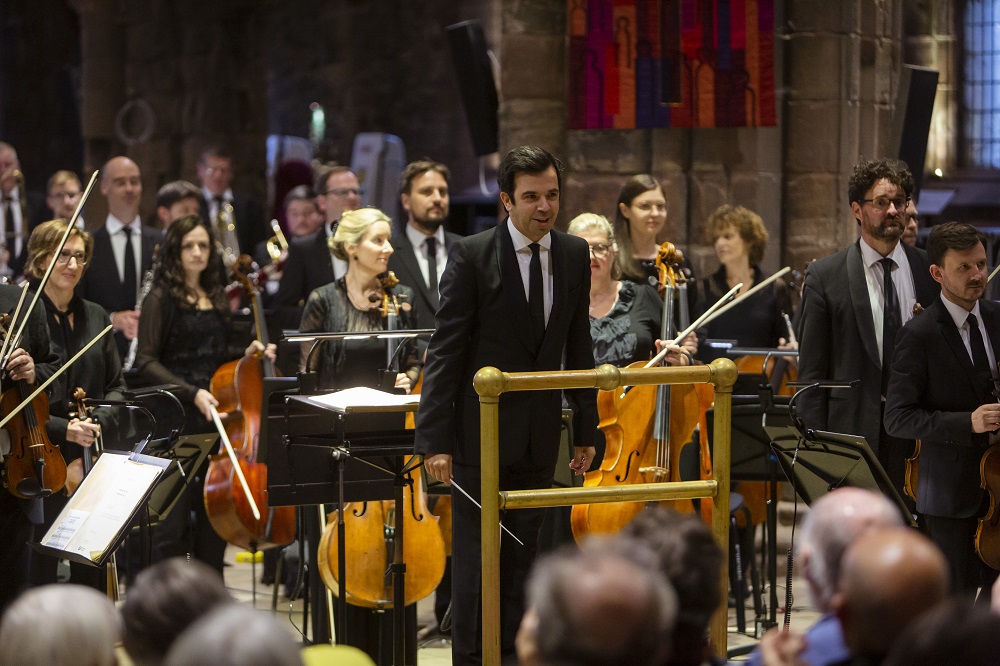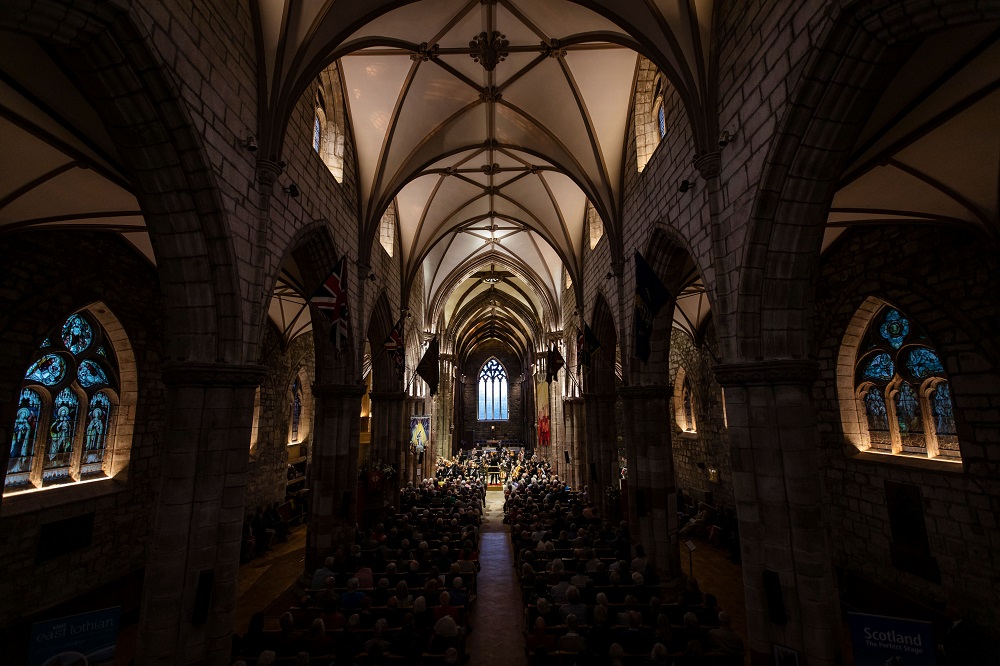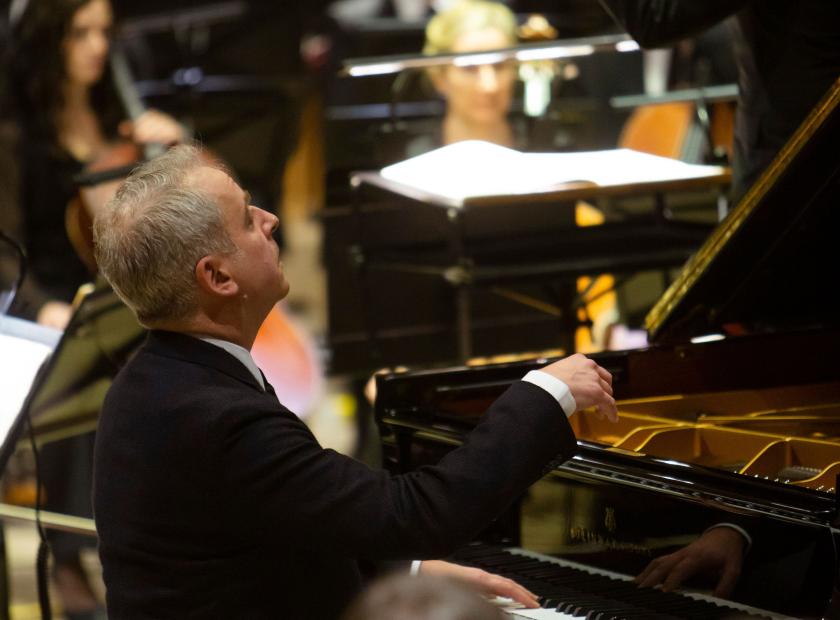Once the shock of Queen Elizabeth’s death has faded, attention will surely turn to the many organisations and institutions of which she was patron. This concert not only marked the Royal Scottish National Orchestra’s debut at the Lammermuir Festival, but it was also the first the orchestra had played since the departure of Her Majesty.
Dressed in sombre black ties, the players preceded the main programme with the national anthem and a minute’s silence, out of which emerged the chalky darkness of Sibelius’ Fourth Symphony. The circumstances were oddly appropriate for the way this symphony begins. It’s a work birthed in darkness and redolent with gloom; a symphony which is easier to appreciate than to love. There is so little in this musical world that seems capable of generating a smile. This is a dark, forbidding universe that lacks even the shimmer of arctic frost that you find in many of Sibelius’ other symphonies, and the orchestral sound that conductor Rory Macdonald shaped in this performance seemed to identify with that.
Sepulchral lower colours in the opening dominated the sound picture throughout, with only the winds capable of penetrating the darkness, especially in the Scherzo. The brass seemed intermittently bright, but were eventually engulfed in the penumbral gloom, and even the rich, velvety strings of the slow movement delivered precious little relief. I often think this scarcely feels like a symphony at all, more like a study in obscuring and obfuscation. Macdonald (pictured below) shaped the music very ably, allowing it to wilt and decay at its own pace. If that seems like faint praise then it’s more for the symphony than for him.  The Lammermuir Festival is a cultural gem in Scotland’s year, bridging the gap between the cornucopic richness of the Edinburgh Festivals and the gloom of the clocks’ changing. Festival Directors Hugh Macdonald and James Waters have worked hard to build an atmosphere of discernible quality and of artistic collaboration, and one of their recent successes has been to build the relationship with American pianist Jeremy Denk. Denk’s residency at the 2021 festival was such a success that he’s back for the duration of this year’s too, and the decision to make Brahms’ mighty Second Piano Concerto the centrepiece of this programme is both a testament to Denk’s skill and a powerful way to inaugurate the festival’s relationship with the RSNO.
The Lammermuir Festival is a cultural gem in Scotland’s year, bridging the gap between the cornucopic richness of the Edinburgh Festivals and the gloom of the clocks’ changing. Festival Directors Hugh Macdonald and James Waters have worked hard to build an atmosphere of discernible quality and of artistic collaboration, and one of their recent successes has been to build the relationship with American pianist Jeremy Denk. Denk’s residency at the 2021 festival was such a success that he’s back for the duration of this year’s too, and the decision to make Brahms’ mighty Second Piano Concerto the centrepiece of this programme is both a testament to Denk’s skill and a powerful way to inaugurate the festival’s relationship with the RSNO.
It didn’t always work, but when it did it was tremendous. Denk is a unique character in the pianistic universe: his playing of Brahms’ piano part was impetuous, forward-thrusting and exciting, full of a refusal to be bound by anything so quotidian as a tempo marking or a bar line. That created thrilling attack in the Scherzo and an exploratory sense of freshness in the finale, but on the way there it produced some uncomfortable congestions of chords in much of the first movement, and the improvisatory nature of the slow movement took a while to settle in. Nor did Macdonald seem quite to manage the orchestral sound effectively. For one thing it was often jarringly fast, particularly in the first movement where the magical moment at the start of the recapitulation sounded disappointingly perfunctory, and it was impossible sufficiently to relax into the Andante third movement.  However, the speed added lightness to the finale, and meant that the Scherzo was never allowed to growl unduly. Furthermore, the big acoustic of St Mary’s Church (pictured above) seemed to suit the music very well, bringing it right up to the ear in a way that you don’t find in a beautifully blended concert hall. The Lammermuir Festival has long had a fruitful relationship with Scotland’s other orchestras: the RSNO has come later to the party. This was a strongly executed and well-planned debut, and I can see them becoming a powerful component of the festival’s future.
However, the speed added lightness to the finale, and meant that the Scherzo was never allowed to growl unduly. Furthermore, the big acoustic of St Mary’s Church (pictured above) seemed to suit the music very well, bringing it right up to the ear in a way that you don’t find in a beautifully blended concert hall. The Lammermuir Festival has long had a fruitful relationship with Scotland’s other orchestras: the RSNO has come later to the party. This was a strongly executed and well-planned debut, and I can see them becoming a powerful component of the festival’s future.














Add comment